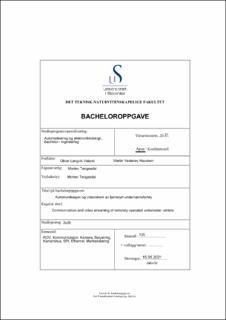Kommunikasjon og videostrøm av fjernstyrt undervannsfartøy
| dc.contributor.advisor | Morten Tengesdal | |
| dc.contributor.author | Martin Vesterøy Hausken | |
| dc.contributor.author | Oliver Langvik Veland | |
| dc.date.accessioned | 2022-03-17T16:51:31Z | |
| dc.date.available | 2022-03-17T16:51:31Z | |
| dc.date.issued | 2021 | |
| dc.identifier | no.uis:inspera:78983214:35056080 | |
| dc.identifier.uri | https://hdl.handle.net/11250/2985953 | |
| dc.description.abstract | Uis Subsea er en studentorganisasjon ved universitetet i Stavanger. Organisasjonen ble opprettet i 2013 og har hvert år et mål om å delta i den internasjonale undervannsfartøy konkurransen som blir arrangert av Marine Advanced Technology Education Center(MATE). Vi skal i den sammenheng bygge en ny ROV som vi skal bruke i konkurransen. I denne rapporten tar vi for oss kamerasystemet, kommunikasjonen mellom datamaskinen og ROV-en samt belysning rundt ROV-en. Kamerasystemet består av to IP-kamera. Vi har valgt å plassere et kamera framme på ROV-en som skal gi god oversikt over omgivelsene og manipulatoren. Vi har og plassert et kamera under ROV-en som skal gi oss oversikt over hva som skjer under ROV-en. Dette kameraet skal og brukes til oppgavene om autonom kjøring i MATE-konkurransen. For å feste dette kameraet til ROV-en har vi laget et kamerahus som vi fester til rammen til ROV-en. Kameraene blir så koblet til en svitsj som er plassert i elektronikkhuset til ROV-en. Videostrømmen blir så sendt til datamaskinen på overflaten hvor den blir behandlet av bildebehandlingsgruppen. For kommunikasjonssystemet i år har vi bestemt oss for å gå for en ny løsning. Her har vi brukt en modul som gjør Ethernet-pakker om til SPI-signal. Modulen kobles til SPI-bussen til mikrokontrolleren i ROV-en. Modulen blir så koblet til svitsjen i elektronikkhuset. Fra svitsjen skal vi bruke fiber som vårt transmisjonsmedium opp til datamaskinen på land. Modulen fungerer som en HTTP-tjener hvor vi har en egen IP-adresse til SPI/Ethernet-modulen. Ved bruk av HTTP-forespørsler i JavaScript kan vi hente ut og endre verdiene til variablene i mikrokontrolleren. Her kan vi lese av verdiene fra sensorene og sende ned styringsdata fra XBOX-kontrolleren. Til belysning på ROV-en har vi valgt å bruke LED-dioder som vi skal plassere rundt ROV-en hvor det er greit å ha lys. LED-diodene blir koblet til en LED-driver som er plassert i elektronikkhuset. Vi får 12V ut fra strømforsyningen, dette skal driveren gjøre om til 16V slik at lysene fungerer optimalt. Vi har ennå ikke fått testet ROV-en i sin helhet, men har testet delene hver for seg. Ut ifra testene ser vi at programmet fungerer, men det kommer nok til å bli et par endringer i tiden frem mot konkurransen slik at ROV-en fungerer best mulig. | |
| dc.description.abstract | Uis Subsea is a student organization at the University of Stavanger. The organization was established in 2013 and each year has a goal of participating in the international underwater vehicle competition organized by the Marine Advanced Technology Education Center (MATE). In this connection, we will build a new ROV that we will use in the competition. In this report, we go through the camera system, the communication between the computer and the ROV, as well as the lighting around the ROV. The camera system consists of two IP cameras. We have chosen to place a camera in front of the ROV which will give a good overview of the surroundings and the manipulator. We have also placed a camera under the ROV that will give us an overview of what is happening under the ROV. This camera will also be used for the tasks of autonomous driving in the MATE competition. To attach this camera to the ROV, we have made a camera body that we attach to the frame of the ROV. The cameras are then connected to a switch located in the electronics housing of the ROV. The video stream is then sent to the computer on the surface where it is processed by the image processing group. For the communication system this year, we have decided to go for a new solution. Here we have used a module that converts Ethernet packets to SPI signal. The module connects to the SPI bus of the microcontroller in the ROV. The module is then connected to the switch in the electronics housing. From the switch, we will use fiber as our transmission medium up to the computer on land. The module works as an HTTP server where we have a separate IP address for the SPI / Ethernet module. Using HTTP requests in JavaScript, we can retrieve and change the values of the variables in the microcontroller. Here we can read the values from the sensors and send down control data from the XBOX controller. For lighting on the ROV, we have chosen to use LEDs that we will place around the ROV where it is nice to have light. The LEDs are connected to an LED driver located in the electronics housing. We get 12V from the power supply, this the driver will convert to 16V so that the lights work optimally. We have not yet tested the ROV in its entirety, but have tested the parts separately. Based on the tests, we see that the program works, but there will probably be a couple of changes in the time leading up to the competition so that the ROV works best. | |
| dc.language | nob | |
| dc.publisher | uis | |
| dc.title | Kommunikasjon og videostrøm av fjernstyrt undervannsfartøy | |
| dc.type | Bachelor thesis |
Tilhørende fil(er)
Denne innførselen finnes i følgende samling(er)
-
Studentoppgaver (TN-IDE) [823]
Studentoppgaver i informasjonsteknologi, datateknikk / kybernetikk, signalbehandling
